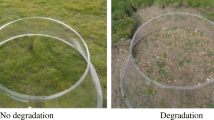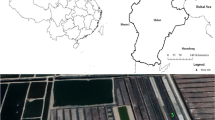Abstract
Background and aim
Nutrient distribution and carbon fluxes upon spring thaw are compared in mesocosms from high arctic and subarctic ecosystems dominated by Cassiope tetragona or Salix hastata/Salix arctica, in order to evaluate the possibility of plant and microbial utilization of an organic compound in thawing permafrost and surface soil.
Methods
Double labeled glycine (13C15N) was added to soil columns with vegetation and to permafrost. During thaw conditions ecosystem respiration 13C was measured and 13C and 15N distribution in the ecosystem pools was quantified one day and one month after glycine addition.
Results
Near-surface soil microbes were more efficient in the uptake of intact glycine immediately upon thaw than plants. After one month plants had gained more 15N whereas microbes seemed to lose 15N originating from glycine. We observed a time lag in glycine degradation upon permafrost thaw, in contrast to surface soil thaw.
Conclusions
Our results suggest that both arctic plants and microorganisms acquire amino acids released upon spring and permafrost thaw. Despite indications of more efficient utilization of added substrate in the High Arctic than the Subarctic, we conclude that patterns of nutrient distribution are similar and predictions based on subarctic data valid for high arctic settings.








Similar content being viewed by others
References
Andresen LC, Jonasson S, Strom L, Michelsen A (2008) Uptake of pulse injected nitrogen by soil microbes and mycorrhizal and non-mycorrhizal plants in a species-diverse subarctic heath ecosystem. Plant Soil 313:283–295. doi:10.1007/s11104-008-9700-7
Andresen LC, Michelsen A, Jonasson S, Beier C, Ambus P (2009) Glycine uptake in heath plants and soil microbes responds to elevated temperature, CO2 and drought. Acta Oecol 35:786–796. doi:10.1016/j.actao.2009.08.010
Bending GD, Read DJ (1996) Nitrogen mobilization from protein-polyphenol complex by ericoid and ectomycorrhizal fungi. Soil Biol Biochem 28:1603–1612. doi:10.1016/S0038-0717(96)00258-1
Berendse F, Jonasson S (1992) Nutrient use and nutrient cycling in northern ecosystems. In: Chapin FS III, Jefferies RL, Reynolds JF, Shaver GR, Svoboda J, Chu EW (eds) In: Arctic ecosystems in a changing climate: an ecophysiological perspective. Academic Press, Inc, San Diego, pp 337–356
Brookes PC, Landman A, Pruden G, Jenkinson DS (1985) Chloroform fumigation and the release of soil-nitrogen - a rapid direct extraction method to measure microbial biomass nitrogen in soil. Soil Biol Biochem 17:837–842. doi:10.1016/0038-0717(85)90144-0
Callaghan TV, Björn LO, Chernov Y et al (2004) Effects on the function of arctic ecosystems in the short- and long-term perspectives. Ambio 33:448–458. doi:10.1639/0044-7447(2004)033
Chapin FS, Moilanen L, Kielland K (1993) Preferential use of organic nitrogen for growth by a nonmycorrhizal arctic sedge. Nature 361:150–153. doi:10.1038/361150a0
Christiansen CT, Schmidt NM, Michelsen A (2012a) High arctic dry heath CO2 exchange during the early cold season. Ecosystems 15:1083–1092. doi:10.1007/s10021-012-9569-4
Christiansen CT, Svendsen SH, Schmidt NM, Michelsen A (2012b) High arctic heath soil respiration and biogeochemical dynamics during summer and autumn freeze-in - effects of long-term enhanced water and nutrient supply. Glob Chang Biol 18:3224–3236. doi:10.1111/j.1365-2486.2012.02770.x
Clemmensen KE, Sorensen PL, Michelsen A, Jonasson S, Strom L (2008) Site-dependent N uptake from N-form mixtures by arctic plants, soil microbes and ectomycorrhizal fungi. Oecologia 155:771–783. doi:10.1007/s00442-008-0962-9
Collins M, Knutti R, Arblaster J (2013) Long-term climate change: projections, Commitents and irreversibility. In: Stocker TF, Qin D, Plattner G-K, Tignor M, Allen SK, Boschung J, Nauels A, Xia Y, Bex V, Midgley PM (eds) In: Climate Change 2013: The Physical Science Basis. Contribution of Working Group I to the Fifth Assessment Report of the Intergovernmental Panel on Climate Change. Cambridge University Press, Cambridge, United Kingdom and New York, pp 1029–1136
Crowther TW, Todd-Brown KEO, Rowe CW et al (2016) Quantifying global soil carbon losses in response to warming. Nature 540:104–108. doi:10.1038/nature20150
Elberling B, Michelsen A, Schädel C, Schuur EAG, Christiansen HH, Berg L, Tamstorf MP, Sigsgaard C (2013) Long-term CO2 production following permafrost thaw. Nat Clim Chang 3:890–894. doi:10.1038/Nclimate1955
Elmendorf SC, Henry GHR, Hollister RD et al (2012) Plot-scale evidence of tundra vegetation change and links to recent summer warming. Nat Clim Chang 2:453–457. doi:10.1038/Nclimate1465
Epstein HE, Myers-Smith I, Walker DA (2013) Recent dynamics of arctic and sub-arctic vegetation. Environ Res Lett 8:015040. doi:10.1088/1748-9326/8/1/015040
Ernakovich JG, Wallenstein MD (2015) Permafrost microbial community traits and functional diversity indicate low activity at in situ thaw temperatures. Soil Biol Biochem 87:78–89. doi:10.1016/j.soilbio.2015.04.009
Farrell M, Hill PW, Farrar J et al (2013) Oligopeptides represent a preferred source of organic N uptake: a global phenomenon? Ecosystems 16:133–145. doi:10.1007/s10021-012-9601-8
Henry HAL, Jefferies RL (2003) Plant amino acid uptake, soluble N turnover and microbial N capture in soils of a grazed Arctic salt marsh. J Ecol 91:627–636. doi:10.1046/j.1365-2745.2003.00791.x
Hobbie JE, Hobbie EA (2012) Amino acid cycling in plankton and soil microbes studied with radioisotopes: measured amino acids in soil do not reflect bioavailability. Biogeochemistry 107:339–360. doi:10.1007/s10533-010-9556-9
Hugelius G, Strauss J, Zubrzycki S et al (2014) Estimated stocks of circumpolar permafrost carbon with quantified uncertainty ranges and identified data gaps. Biogeosciences 11:6573–6593. doi:10.5194/bg-11-6573-2014
Illeris L, Konig SM, Grogan P, Jonasson S, Michelsen A, Ro-Poulsen H (2004) Growing-season carbon dioxide flux in a dry subarctic heath: responses to long-term manipulations. Arct Antarct Alp Res 36:456–463. doi:10.1657/1523-0430(2004)036
Keeling CD (1961) The concentration and isotopic abundances of carbon dioxide in rural and marine air. Geochim Cosmochim Ac 24:277–298. doi:10.1016/0016-7037(61)90023-0
Keuper F, van Bodegom PM, Dorrepaal E, Weedon JT, van Hal J, van Logtestijn RSP, Aerts R (2012) A frozen feast: thawing permafrost increases plant-available nitrogen in subarctic peatlands. Glob Chang Biol 18:1998–2007. doi:10.1111/j.1365-2486.2012.02663.x
Kielland K (1995) Landscape patterns of free amino acids in arctic tundra soils. Biogeochemistry 31:85–98
Krab EJ, Cornelissen JHC, Lang SI, van Logtestijn RSP (2008) Amino acid uptake among wide-ranging moss species may contribute to their strong position in higher-latitude ecosystems. Plant Soil 304:199–208. doi:10.1007/s11104-008-9540-5
Larsen KS, Ibrom A, Jonasson S, Michelsen A, Beier C (2007) Significance of cold-season respiration and photosynthesis in a subarctic heath ecosystem in northern Sweden. Glob Chang Biol 13:1498–1508
Larsen KS, Michelsen A, Jonasson S, Beier C, Grogan P (2012) Nitrogen uptake during fall, winter and spring differs among plant functional groups in a subarctic heath ecosystem. Ecosystems 15:927–939. doi:10.1007/s10021-012-9555-x
Mack MC, Schuur EAG, Bret-Harte MS, Shaver GR, Chapin FS (2004) Ecosystem carbon storage in arctic tundra reduced by long-term nutrient fertilization. Nature 431:440–443. doi:10.1038/nature02887
Michelsen A, Quarmby C, Sleep D, Jonasson S (1998) Vascular plant 15N natural abundance in heath and forest tundra ecosystems is closely correlated with presence and type of mycorrhizal fungi in roots. Oecologia 115:406–418. doi:10.1007/s004420050535
Nordin A, Schmidt IK, Shaver GR (2004) Nitrogen uptake by arctic soil microbes and plants in relation to soil nitrogen supply. Ecology 85:955–962. doi:10.1890/03-0084
Olsrud M, Michelsen A (2009) Effects of shading on photosynthesis, plant organic nitrogen uptake, and root fungal colonization in a subarctic mire ecosystem. Botany 87:463–474. doi:10.1139/B09-021
Rousk K, Michelsen A, Rousk J (2016) Microbial control of soil organic matter mineralisation responses to labile carbon in subarctic climate change treatments. Glob Chang Biol. doi:10.1111/gcb.13296
Schaefer K, Zhang TJ, Bruhwiler L, Barrett AP (2011) Amount and timing of permafrost carbon release in response to climate warming. Tellus B 63:165–180. doi:10.1111/j.1600-0889.2011.00527.x
Schimel JP, Chapin FS (1996) Tundra plant uptake of amino acid and NH4 + nitrogen in situ: plants compete well for amino acid N. Ecology 77:2142–2147. doi:10.2307/2265708
Schuur EAG, Crummer KG, Vogel JG, Mack MC (2007) Plant species composition and productivity following permafrost thaw and thermokarst in alaskan tundra. Ecosystems 10:280–292. doi:10.1007/s10021-007-9024-0
Schuur EAG, McGuire AD, Schädel C et al (2015) Climate change and the permafrost carbon feedback. Nature 520:171–179. doi:10.1038/nature14338
Semenchuk PR, Elberling B, Amtorp C, Winkler J, Rumpf S, Michelsen A, Cooper EJ (2015) Deeper snow alters soil nutrient availability and leaf nutrient status in high Arctic tundra. Biogeochemistry 124:81–94. doi:10.1007/s10533-015-0082-7
Sokolovski SG, Meharg AA, Maathuis FJM (2002) Calluna vulgaris Root cells show increased capacity for amino acid uptake when colonized with the mycorrhizal fungus Hymenoscyphus ericae. New Phytol 155:525–530. doi:10.1046/j.1469-8137.2002.00485.x
Sorensen PL, Clemmensen KE, Michelsen A, Jonasson S, Strom L (2008a) Plant and microbial uptake and allocation of organic and inorganic nitrogen related to plant growth forms and soil conditions at two subarctic tundra sites in Sweden. Arct Antarct Alp Res 40:171–180. doi:10.1657/1523-0430(06-114)
Sorensen PL, Michelsen A, Jonasson S (2008b) Ecosystem partitioning of 15N-glycine after long-term climate and nutrient manipulations, plant clipping and addition of labile carbon in a subarctic heath tundra. Soil Biol Biochem 40:2344–2350. doi:10.1016/j.soilbio.2008.05.013
Sorensen PL, Michelsen A, Jonasson S (2008c) Nitrogen uptake during one year in subarctic plant functional groups and in microbes after long-term warming and fertilization. Ecosystems 11:1223–1233. doi:10.1007/s10021-008-9204-6
Vance ED, Brookes PC, Jenkinson DS (1987) An extraction method for measuring soil microbial biomass-C. Soil Biol Biochem 19:703–707
Voigt C, Lamprecht RE, Marushchak ME, Lind SE, Novakovskiy A, Aurela M, Martikainen PJ, Biasi C (2016) Warming of subarctic tundra increases emissions of all three important greenhouse gases - carbon dioxide, methane and nitrous oxide. Glob Chang Biol (in press). doi:10.1111/gcb.13563
Wu J, Joergensen RG, Pommerening B, Chaussod R, Brookes PC (1990) Measurement of soil microbial biomass C by fumigation extraction - an automated procedure. Soil Biol Biochem 22:1167–1169
Acknowledgments
We acknowledge The Danish Council for Independent Research and The Danish National Research Foundation (CENPERM DNRF100) for financial support. We thank Simone Gress Hansen and Sille Juline Høgly Petersen for assistance with sorting of mesocosms and sample preparation, and Gosha Sylvester for assistance with nutrient analysis. We also thank Per Ambus for internal review and constructive comments.
Author information
Authors and Affiliations
Corresponding author
Additional information
Responsible Editor: Ad C. Borstlap .
Electronic supplementary material
Online Resource 1
(DOCX 37 kb)
Online Resource 2
(DOCX 28 kb)
Rights and permissions
About this article
Cite this article
Ravn, N.M.R., Elberling, B. & Michelsen, A. The fate of 13C15N labelled glycine in permafrost and surface soil at simulated thaw in mesocosms from high arctic and subarctic ecosystems. Plant Soil 419, 201–218 (2017). https://doi.org/10.1007/s11104-017-3322-x
Received:
Accepted:
Published:
Issue Date:
DOI: https://doi.org/10.1007/s11104-017-3322-x




